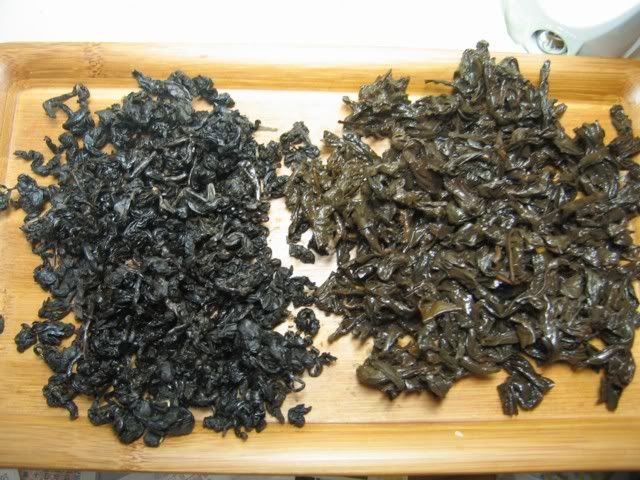
The above photo consists of two sets of leaves. On the left are the leaves of the roasted oolong I had yesterday. On the right are the aged tieguanyin I had today. Put together, I think the contrast is much more obvious. You can not only see the colour differential, but also the way the leaves are — one’s much more open, flexible-looking, and lively, while the roasted one is quite black, don’t really unfurl, and if you try to pry it open, breaks apart as it is very brittle.
Reminds me of cooked and raw puerh… or maybe wet stored and dry stored puerh.
Now, obviously, the parallel isn’t exactly. The tieguanyin in this case must’ve been roasted as well, as some of the leaves show evidence of that. However, it is the degree that matters… and I find, in the case of aged oolongs, that lightly roasted and then left alone, they produce the most interesting results. Lively and vibrant, they retain some of the original character of the tea while having changed enough so that you won’t recognize it. The roasted stuff are softer, mellower, but lacking in that liveliness that really spices things up (sometimes literally). I like it still better than cooked puerh though.

 RSS - Posts
RSS - Posts
5 responses so far ↓
lewperin // December 4, 2007 at 3:57 pm |
Thanks for bringing this up. I think about these parallels with regard to tea liveliness a lot. I have the feeling that there must be some scientific work being done somewhere in the tea industry that bears on this. Have you ever tried hunting for this sort of thing in Chinese?
xcasper54x // December 4, 2007 at 9:18 pm |
What prevents the lightly roasted and left alone ones from going stale? Is the light roast really enough to keep it for many years?
MarshalN // December 4, 2007 at 11:37 pm |
Lew: I don’t think these really exist much in China. There isn’t the notion that you can drink this stuff, except for Wuyi teas, but the age on those are generally lower — just a few years, usually. I think I will have better luck hunting for these in Guangdong or Fujian, which I haven’t tried. The ones I’ve had were all new stuff masquerading as old.
Casper: Good question — but it seems like if kept well… one strongish roasting is enough. The key is to drive the moisture out of the leaves to the point where it won’t go nasty on you.
lewperin // December 5, 2007 at 1:58 pm |
I don’t think I made myself clear. What I meant to ask was, have you tried hunting for scientific papers in Chinese regarding what factors in the manufacturing process make for tea that will stay lively and supple for many years. Some factors might be pre- and post-fermentation, roasting, and wet vs. dry storage, but there are probably others. I don’t think the mostly Indian scientists who publish tea research in English worry about this. I figure the situation is probably similar in Japanese (not that I could tell!) But in Chinese…
MarshalN // December 5, 2007 at 9:48 pm |
Nope, haven’t tried